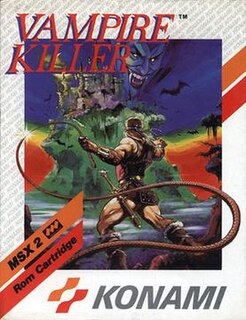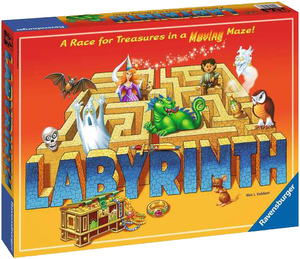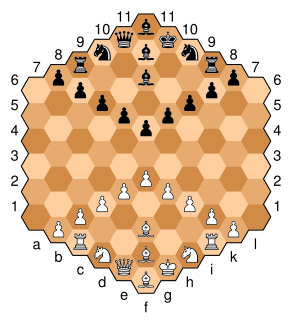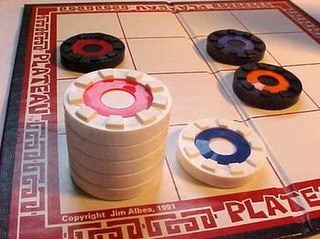Overview, objective and structure
Labyrinth is played with a minimum of three people, one of whom is the game master. Each participant should have paper (preferably graph paper) and a pen or (preferably) a pencil. Players take turns as the game master, for one game each. Rules are agreed on before beginning a series of games.
The game ends when only one player is left alive, or when one of the players exits the labyrinth with the treasure(s). Each player keeps track of all movements, directives and requests, recreating the labyrinth structure on their notepad.
The square labyrinth's size determines the complexity and length of the game. Sizes range from 4 by 4 inches (100 mm × 100 mm) to 10 by 10 inches (250 mm × 250 mm) or 12 by 12 inches (300 mm × 300 mm). Each cell in the labyrinth may be one of the following:
- Empty
- Wormholes (optional), organized into sets
- River (optional), with source and end: Several cells arranged in a chain which cannot intersect itself
- Hospital (optional)
- Arsenal, some of whose weapons a player may take when entering it
- Treasure: At least one empty cell
A wall can be built between any two neighbouring cells. The outside wall, known as the monolith, must have at least one exit (a space) so players can leave the labyrinth.
Gameplay
The game master creates the labyrinth. They and the players agree on the rules. At the start of the game, the game master sets the number and length of wormhole chains, rivers (if any) and weapon-related parameters such as the number of arsenals and the starting size of a player's weapons kit.
Players take turns. With each turn, a player can move their marker to a neighbouring cell (a cell with a common, non-diagonal border with their current cell). After each move, the game master tells the player whether their move is possible. If it is, they tell the player what type of cell their marker is on: empty, arsenal, river, wormhole, exit, etc. If it is an obstacle, the game master tells the player if it is an ordinary wall or the monolith (labyrinth boundary). If a player shoots, then the game master tells them if another player is wounded or killed. All game-master announcements are made aloud, and players cannot form alliances or exchange information in secret.
After learning the labyrinth parameters, each player secretly tells the game master where they want their marker placed at the beginning of the game; the game master may also place the markers randomly, so the players do not know their initial positions. Each player has a starting arsenal, with a set of weapons.
Players move by making a step in any direction (saying "up", "down", "left" or "right"), or opting to skip a step. They can shoot in any direction before and after making a step, and the bullet travels in the stated direction until it hits a wall or a player. If it hits a player, they are declared wounded (or killed) by the game master. A player can stab by saying, "Use knife". If another player is in the same cell, they will be wounded or killed; the used knife is discarded. Players can blow up a wall in any direction by saying, "Throw grenade left/right/up/down", with the game master announcing the result.
Any combination of weapons use can be used with any type of step request. When a step directive is given, the game master tries to move the marker in the requested direction and announces the result. If a player's marker moves to a wormhole, it automatically moves to the cell with the next wormhole in the chain. If the current position is the last one in the chain, the marker is moved to the chain's first wormhole. If a marker is moved into a river, it is then moved two cells downriver; if one of the cells is the river end, the marker stops there. If the marker is already in the river (but not at the end), the player can skip the step and the marker will flow downriver. If a marker is in the arsenal, the player's starting weapons are restored or they receive an additional set. If a wounded player is in the hospital, their health is restored. A wounded player cannot use weapons or carry treasure. If a player carrying treasure is wounded, the treasure remains in that cell until it is picked up. If the player is wounded in the river, the treasure flows two cells downriver after every move to the river end, where it can be picked up.

Chinese checkers or Chinese chequers is a strategy board game of German origin which can be played by two, three, four, or six people, playing individually or with partners. The game is a modern and simplified variation of the game Halma.

HeroQuest, sometimes written as Hero Quest, is an adventure board game created by Milton Bradley in conjunction with the British company Games Workshop. The game was loosely based around archetypes of fantasy role-playing games: the game itself was actually a game system, allowing the gamemaster to create dungeons of their own design using the provided game board, tiles, furnishings and figures. The game manual describes Zargon/Morcar as a former apprentice of Mentor, and the parchment text is read aloud from Mentor's perspective.

Vampire Killer is a platform-adventure video game released by Konami for the MSX2 computer on October 30, 1986. It is a parallel version of the original Castlevania, which debuted a month earlier for the Famicom Disk System under the same Japanese title. However, the MSX2 version was localized first in Europe and thus, was published without the Castlevania branding that the franchise would start using abroad in 1987 when the NES version was released in North America.

Greyhawk Wars is a fantasy board wargame that was published by TSR, Inc. in 1991. The game was designed by David Cook as a strategic simulation of the eponymous Greyhawk Wars on the fictional world of Oerth, the World of Greyhawk campaign setting for the Dungeons & Dragons role-playing game.

Labyrinth is a board game for two to four players, published by Ravensburger in 1986.

Hasami shogi is a variant of shogi. The game has two main variants, and all Hasami variants, unlike other shogi variants, use only one type of piece, and the winning objective is not checkmate. One main variant involves capturing all but one of the opponent's men; the other involves building an unbroken vertical or horizontal chain of five-in-a-row.

Fatal Labyrinth, titled Shi no Meikyuu: Labyrinth of Death (死の迷宮) in Japan, is a role-playing video game developed and published by Sega. Originally available exclusively on the Sega Meganet multiplayer gaming service in 1990, it was later remade for the Sega Genesis in 1991. The game appears in Sonic's Ultimate Genesis Collection for Xbox 360 and PlayStation 3. The game was also released for Microsoft Windows on September 13, 2010. The game is similar to and shares assets with Dragon Crystal, which was also released around that time.

Hexagonal chess refers to a group of chess variants played on boards composed of hexagon cells. The best known is Gliński's variant, played on a symmetric 91-cell hexagonal board.

Dragon Crystal (ドラゴンクリスタル) is a 1990 video game developed and published by Sega for their Game Gear and Master System. The game is similar to and shares assets with Fatal Labyrinth, which was also released around that time.

Rapid Reload, known in Japan as Gunners Heaven (ガンナーズヘヴン), is a run and gun video game developed by Media.Vision and published by Sony Computer Entertainment for the PlayStation in both Japan and Europe in 1995. The game was re-released on the PlayStation Network in Japan in 2007 and in Asia in 2010.
The word "portal" in science fiction and fantasy generally refers to a technological or magical doorway that connects two distant locations separated by spacetime. It usually consists of two or more gateways, with an object entering one gateway leaving via the other instantaneously.
Sannin shōgi, or in full kokusai sannin shōgi, is a three-person shogi variant invented circa 1930 by Tanigasaki Jisuke and recently revived. It is played on a hexagonal grid of border length 7 with 127 cells. Standard shogi pieces may be used, and the rules for capture, promotion, drops, etc. are mostly similar to standard shogi. While piece movement differs somewhat from standard shogi, especially in the case of the powerful promoted king, the main difference in play is due to the rules for voluntary and mandatory alliance between two of the three players.
P. P. Hammer and his Pneumatic Weapon is a video game for the Amiga and Commodore 64 developed by Traveling Bits Production. It is a platform game with puzzle elements. It is influenced by 1982's Lode Runner. In the game, the player controls a character called P. P. Hammer, who is on a quest to discover and acquire all treasures from a series of more than 60 levels.

The Nintendo Entertainment System version of Gauntlet is an original game based on the Gauntlet arcade game, with a unique storyline and 100 levels.

Plateau is a two-player abstract strategy board game invented by Jim Albea.

The Dungeons & Dragons Computer Labyrinth Game was an electronic board game released by Mattel in 1980.

Rhombic chess is a chess variant for two players created by Tony Paletta in 1980. The gameboard has an overall hexagonal shape and comprises 72 rhombi in three alternating colors. Each player commands a full set of standard chess pieces.

Triangular chess is a chess variant for two players invented by George R. Dekle Sr. in 1986. The game is played on a hexagon-shaped gameboard comprising 96 triangular cells. Each player commands a full set of chess pieces in addition to three extra pawns and a unicorn.

Quatrochess is a chess variant for four players invented by George R. Dekle Sr. in 1986. The board comprises 14×14 squares minus the four central squares. Each player controls a standard set of sixteen chess pieces, and additionally nine fairy pieces. The game can be played in partnership or all-versus-all.

Hellevator is a 2015 American horror game show produced by Jason Blum for his Blumhouse Productions banner & Todd Lubin in which a team of three contestants rides a haunted elevator through an abandoned slaughterhouse. The show is hosted by Jen and Sylvia Soska and premiered on October 21, 2015 on Game Show Network. The debut episode was watched by 503,000 viewers.

















